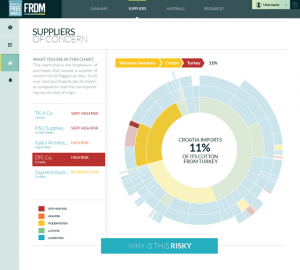Supplier Network Pushing Slavery out of the Supply Chain
Maybe you’ve heard of Ariba before. Maybe you know them from their work with Kroger, Staples, or Dole. Maybe you know them as the largest e-commerce network in the world. Maybe you’ve never hear of them at all, but it’s time to start paying attention to them. Ariba has partnered with Made In A Free World to build a tool for companies to determine how likely their suppliers source from slave labor. It is a dashboard that takes a company’s spending data and supplier information and runs it against a database of over 52,000 products to determine if slavery is anywhere in the supply chain. In some cases, this tool is able to identify suppliers that are known to be offenders of using slave labor. In other cases, it is able to identify regions that a company sources materials from that have a high risk for slave labor.
Here is an excerpt from the Wall Street Journal providing examples of how this tool can be used:
Based on an analysis of suppliers in Ariba’s system, and where those suppliers tend to source their components or raw materials, a construction company might discover it is using iron from China, where the industry is poorly regulated and there is a high probability of forced labor. A search for women’s shirts in Malaysia may reveal cotton from Mali, another potentially problematic region in terms of labor practices.
Ariba encourages all of its customers to use this new freedom tool in their own practices and will continue to grow and update the number of products and suppliers. The tool was designed with their customers and other corporations in mind.  They went to these companies and asked, “what do you need in order to remove slave labor from your supply chain?” Ariba and Made in a Free World are certainly trying to close the knowledge gap surrounding modern slavery
They went to these companies and asked, “what do you need in order to remove slave labor from your supply chain?” Ariba and Made in a Free World are certainly trying to close the knowledge gap surrounding modern slavery
There are many critics who will argue that this tool is idealistic. While it may be a great resource, what is to incentivize a customer of Ariba or any other company to use it? Being forever the optimist, I think this tool is a huge step in the right direction. While it may not be able to pull exact information, it at least gives companies a place to start looking for where they might find slavery in their supply chain, which is better than we can say right now. In order for this tool to be effectively utilized, it will take some urging and pressure from both consumers and the government. Each type of actor hold a piece of the puzzle that is the solution. Any missing piece, and the picture is incomplete. We can continue to be pessimists or realists and say this tool merely offers up incomplete information. Or we can commit to seeing slavery end in our lifetime so that when we are the leaders running these massive companies and have real power to impact supply chains, we are committed to making changes that will eradicate slavery from the supply chain once and for all.